Hard Times In ‘Boomtown, USA’: The Rise And Fall Of Oil In Williston, North Dakota

WILLISTON, North Dakota — Uriah Wilson slouched in a cheap plastic chair, his tired body folding into the seat’s creaky joints. There wasn’t much to do but wait.
It was a bit past 6 a.m. on a recent Tuesday and the job placement center was sleepy here in America's best-known oil boomtown. Wilson, eyes half-open, sat at a circular table covered by a crinkled, fall-themed tablecloth in the building called the Command Center. Around him, guys shuffled between their seats and a carafe of coffee. Conversation was terse and infrequent, the near-silence mingling with ringing phones.
Everyone waited for work. New arrivals pulled open the front door and quickly shut it behind them, choking off an inrush of chilly air. As jobs opened up, employees at the placement center pointed to workers. With time, clusters of men dressed in thick coveralls went out to job sites, but as 6 a.m. turned to 6:30 and then 7 turned to 7:30, there was no work for Wilson.
Williston hasn’t been easy on him. Wilson, 18, left behind everyone he knew in his hometown of Burnsville, Mississippi, when he hopped on a Greyhound bus, tracing through some 1,500 miles of the United States, hoping to earn fat paychecks working long hours on an oil rig. The first few days in North Dakota, he canvassed door-to-door for a job. At night, he slept under a bridge. But the Williston he imagined – where the money flowed as quickly as the oil gushed – was gone.
It’s arguable that no city in the United States has seen more change in the past half-decade than Williston. With billions of barrels of oils suddenly recoverable from the rock formation beneath it, Williston went from an afterthought, another dot in an oft-forgotten state, to the epicenter of an exploding industry. The process shape-shifted the city into America’s boomtown, ushering in an unprecedented era of soaring wages, property values and hopes. But as crude prices have plummeted over the past 18 months amid a global surplus, new struggles engulfed the city, with thousands of jobs disappearing overnight and large swaths of workers up and leaving Williston — and North Dakota in general. Faced with an uncertain future, the small city built around America’s oil rush was left reeling.

The Boom
The boom in Williston was made possible by new technology. Advances in fracking and horizontal drilling made possible the recovery of an estimated 7 billion barrels of oil from the tightly packed Bakken shale formation, the largest contiguous deposits of oil and natural gas in the nation. Fracking made it possible to break the shale apart and horizontal drilling made it possible to pull it out of the ground.
The sprawling but shallow Bakken rests in the larger Williston Basin. The city of Williston is at the center of that basin, and as the oil industry flooded the newly emerged market, the city was placed directly in the middle of the rush. It was the symbol of the industry’s fracking revolution.
Money follows oil and people follow money. That pattern played out starting about five years ago in North Dakota. At its peak, more than 200 drilling rigs were up and running in the state. It became nearly impossible to ignore oil’s prevalence in the city, the local paper even keeping a daily record of the rig count on its front page. By the end of 2013, the average salary in Williston and surrounding Williams County was more than $77,000 as a flood of oil money pushed wages up across the board. Oil workers putting in overtime hours in the fields easily earned $100,000 per year. Williston’s permanent population surged from about 12,000 to an estimated 40,000, after accounting for the oil industry workers who came and went in stints.
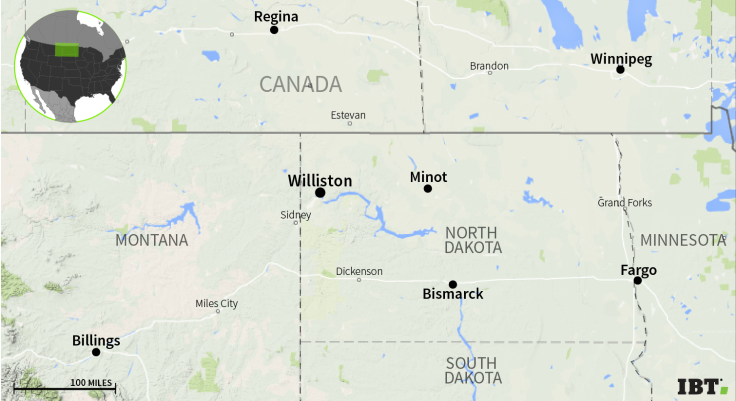
During the boom, construction was ever-present. Glass offices rose above torn-apart, soon to be re-paved, streets. New businesses sprung up along Route 2, the city’s major artery. Chain stores came in bunches: Walmart, Buffalo Wild Wings, Applebee’s, Menard’s. Young locals who had moved away came home, starting up shops in their now exciting city. The city even built a gleaming, $70 million, glass monster of a recreation center, complete with a surfing wave pool, golf simulator and lazy river. The new city surrounded the old Williston, offering a sharp contrast to the main street lined with an old-timey soda and coffee parlor featuring a reclaimed tin ceiling and the Hedderich’s department store, its off-orange blocky script sign hanging over the city.
As oil prices surged at more than $100 per barrel, people from across the country and around the world flooded in, hoping to make a quick buck in the modern version of a gold rush. Rents exploded, with single bedroom apartments costing more than $2,000 per month, and average prices outpacing those in New York City. On the edges of the city, enterprising companies built temporary housing, known as man camps, to shelter the overflowing workers.
Back then, city officials had a running joke about how easy it was to land work. You needed only a pulse, said Cindy Sanford, who manages the government-run jobs services office in town. “We laughingly would say, ‘Breathe on a mirror … OK, try again,’” she recalled. Even the waitresses bragged about earning more than $700 per day.
Hopes ran impossibly high. As recent as last year, people whispered rumors that the growth was going to sustain five generations. In the middle of the city, the tourism board erected a billboard. It read: “Welcome to Williston, ND: Boomtown, USA.”
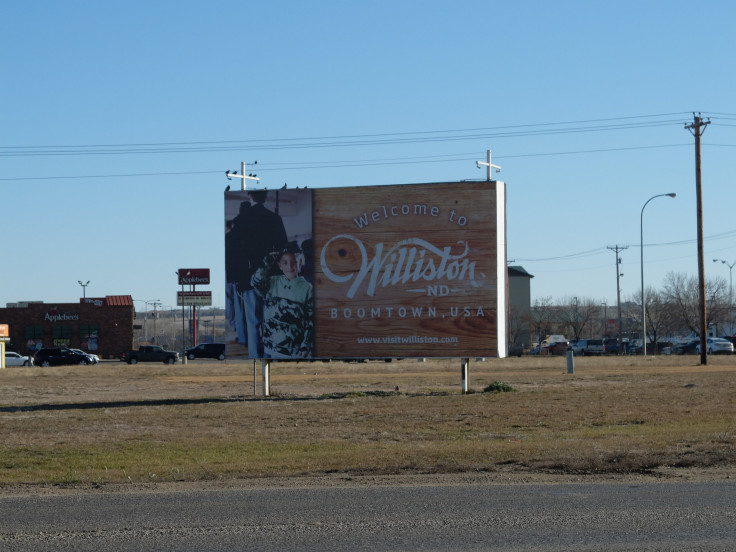
The Industry Dries Up
Oil prices remained high until mid-2014, but as the U.S. began relying less on foreign imports, and amid continued high levels of production from oil-rich countries including the OPEC cartel, the world’s surplus of oil sent prices tumbling to about $40 a barrel. The method of drilling for oil in North Dakota costs far more than traditional methods, so as crude fell the industry pulled back. The rush was over.
Scott Growthe moved to Williston from Nebraska before the boom hit about five years ago. When it took hold, he said he sometimes pulled in nearly $3,000 for a week’s worth of work.
As crude prices dropped, Growthe, who was working as a general contractor for an oil company, watched his co-workers lose their jobs one by one. The rig count, a barometer of oil activity, fell to just 65 by November, about one-third its peak. A year ago, Growthe, too, was laid off.
He passed the time with odds jobs like painting fences and picking up trash. It’s a life based on hustle, word of mouth and some charity. He learned a long time ago never to say no to work.
“Right now, I’m just paying my rent and health insurance and that’s it,” he said. “But I’m OK with it.”
On a recent night, the 54-year-old dug into a hearty slab of meat loaf at Banquet West, a weekly free meal offered Sundays at the local Lutheran church. The warm community room hosted a range of people, from those struggling to make ends meet to those simply looking for company over a hot meal. That Sunday, folks mingled at cafeteria tables over the meat loaf, piles of mashed potatoes and cherry cake with Cool Whip.
After polishing off his dessert, Growthe took a moment to digest and chat with friends. He quietly listened to a new acquaintance enthusiastically discuss the merits of solar energy, interjecting once or twice to poke holes in the man’s boisterousness. Growthe then rose from his table and walked outside the church into a dimly lit parking lot. Away from the crowd, he admitted times had grown tough. At the boom’s peak he made $92,000 per year, easy. Now he struggled to make his $900 per month rent.
Still, he refused to complain. His only major gripe that night about the city was that a standard breakfast – a plate of bacon, eggs and toast – cost $12.50.
“That’s a $6 meal,” he grumbled.
Toll on the Town
On a windy day, families stocked up on thick coats at the Salvation Army store in town, the North Dakota winter playing the first notes in its extended, brutal symphony. The shop had the typically idiosyncratic thrift store merchandise: $1 Christian music records, sneakers, kitchen appliances and used ball caps, to name a few. In a musty corner, a forgotten pot of coffee burned itself bitter.
The store shares a corner with the Salvation Army office that provides social services off Main Street downtown. Inside the cramped space, workers fussed about, answering calls and vacuuming carpets. In a nod to the organization’s religious roots, a top-lit painting of Jesus hung above a stack of donated food. Folks sat in pews in the building’s small chapel, waiting to be helped. One person talked about needing a better jacket. A man sat with a toddler in his lap.
“What we’re dealing with are people who have been in town and they’ve lost their jobs,” said Captain Joshua Stansbury, who heads up Williston’s Salvation Army. “Now they’re being laid off and so, in some situations they’ve lost their job and their housing within 24 hours.”
The Salvation Army helps about 25 people per day. People come in and grab handfuls of bagels and assorted rolls from crates lining the wall of a tiny hallway. Some meet with social workers and others use desktops in a computer room. But sometimes the best move is to help people find a way out of Williston.
“There’s people we’re sending back home on buses, giving them a bus ticket or helping them get gas in their car for the next destination,” Stansbury said.
Even those who have never worked a rig in their life have been hit hard. Jesse Gerling, a worker at the Salvation Army and a Williston native, used to pay $350 a month to park his RV on a sliver of land outside the city. But as prices surged during the boom, the fee climbed to $850. Now to make ends meet, Gerling eats whatever is on special at the supermarket and collects disability checks for an injury he suffered in an accident. If prices don’t return to normal, he said he’d have no choice but to leave his hometown.
“It’s gotten hard for folks,” he said.
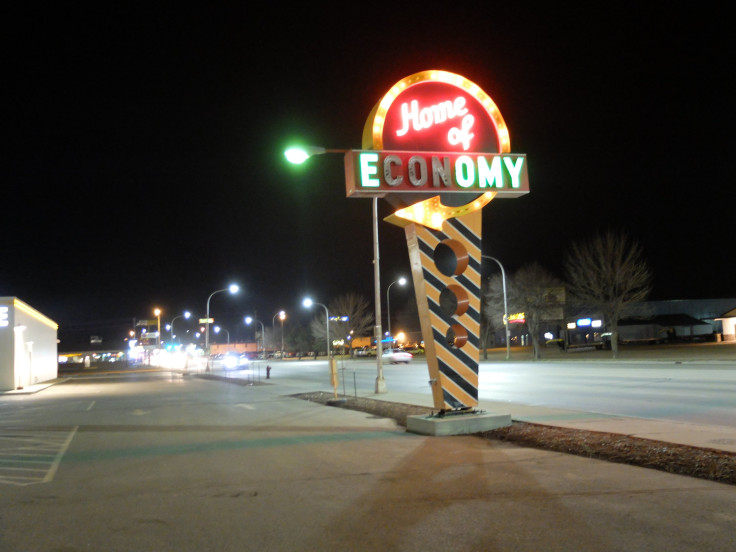
'Slowed Down Across the Board'
Not far from the bustle of Route 2, cookie-cutter condos form new neighborhoods in Williston. Banners proclaim “now leasing” and signs advertising openings accompany empty driveways.
Oil’s far-reaching tentacles touched just about everything in Williston, but with people now flooding out of the city, perhaps the hardest-hit sector was real estate. Much of the residential construction was planned with the assumption that people would keep moving to town. The day-to-day population was expected to reach about 50,000 by 2017.
Instead, as jobs dried up and families fled, some residential neighborhoods became ghost towns. City officials estimated hotels and apartments, many of which were built during the boom, were at about 50-60 percent occupancy in November. An office worker at Williston Fox Run, a RV park north of the city, said business had dropped significantly.
“The market’s obviously slowed way down across the board,” said Ryan Visser, an agent at Fredricksen Real Estate in Williston. “So goes oil, so goes the real estate market.”
Visser, 38, said there were more than 400 properties listed for sale, the most in nearly four decades. Those with commercial properties are cutting back, leasing smaller places, “trying to get by,” he said.
As people ditched town, retail also dropped off. In the most recent quarter, taxable sales sank a staggering 16 percent statewide compared with the year prior. The same figure for Williams County sunk more than 35 percent. Visser was an investor in four restaurants in town, including once-bustling bars Williston Brewing Company and Doc Holliday’s Roadhouse, and he said competition was tight.
“There’s been a lot of seats added here, lots of restaurants have started up … that’s made it more difficult now, when lots of people have left,” he said.
Some restaurants started shilling dollar beers as loss-leaders to try to draw interest. Justin Loucks, kitchen manager at 3 Amigos Southwest, a Chipotle-style burrito joint, said the restaurant had to cut hours in half as business slowed significantly. They stopped serving dinner altogether. People weren’t spending like they used to. On a recent day, 3 Amigos was entirely empty, three employees working together to complete a single catering order.
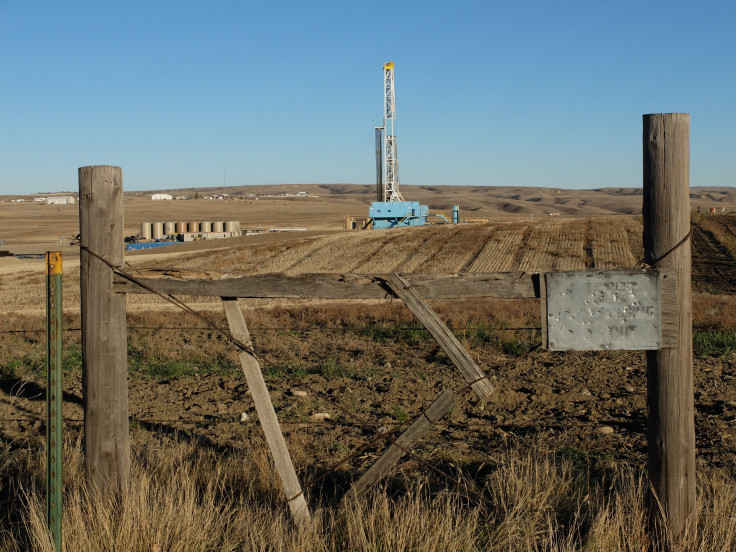
And while there’s still money to be made in Williston, it’s largely not in oil, which fed the massive uptick in purchasing. The open jobs with livable salaries are mostly skilled positions requiring two-year degrees. But many of the people looking for work here are not qualified for those jobs. They still dream, however, of a boomtown gone by.
Kyle Tennessen, branch manager at the Command Center temp agency, has had to temper those expectations.
“They come here thinking the streets are paved with gold,” Tennessen said. “They have all these pipe dreams in their head and then they come in here and I give them a realistic picture.”
The Man Camps' Uncertain Future
Outside of Williston, the landscape morphs into the sparse, rolling vacancy that defines swaths of North Dakota. The chain stores give way to a smattering of bobbing oil derricks, the horizon-line pocked with the flickering lights of gas flares. It’s around this area where many of the temporary man camps rolled into town.
The camps turned largely blank space into mini campuses that, at times, earned the reputation for housing pernicious young oilmen with more money than sense. They were a physical reminder of the growth in Williston, a Band-Aid for the crisis of a sudden influx of bodies.
Target Logistics’ Williston property opened early in the rush and was one of the more luxe man camps, with orderly rows of interconnected white trailers and dorm-style accommodations. It’s hardly roughing it, amenities including flat-screen TVs and a weight room.
Once it was busy at all hours, but layoffs have now left the hallways empty and rooms vacant. The camp was at about 60 or 70 percent filled, Regional Vice President of Operations Travis Kelley said in November. It felt even emptier. Just after 3 p.m. the lunchroom was wide open, just two lonely workers quietly eating, heads down. A few years ago, it would have been full.
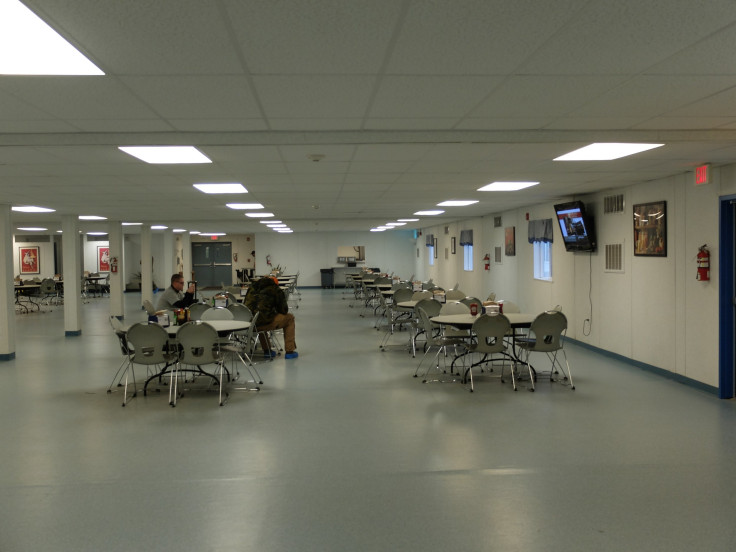
“Nobody has dreams of grandeur [like] it’ll turn around in the next six months,” Kelley said. But if the boom came back, “we’d love to be here,” he said.
But, in perhaps one of the most visible symbols of Williston’s difficult evolution, the end might be near for the work camps. In an effort to boost local hotels and apartments, city commissioners voted Nov. 24 in favor of an ordinance that essentially banned man camps within the city’s jurisdiction starting next July. Proposed amendments have a chance of shelving the ordinance or providing exceptions, but like the oilmen the camps used to house, it could soon be time for the man camps to ship out of Williston.
A Risky Bet
Officials in Williston, while optimistic, know the city is at an inflection point. Scott Meske, who moved from Wisconsin just last year, called himself a “cheerleader” for the city in his role as president of its chamber of commerce. The businesses hit the hardest attempted to exploit the boom to turn a quick profit with a three- to five-year return on investment, he said.
“The problem was we were the best-looking new girl in the lunchroom and everybody was looking at us,” Meske said. “Everybody wanted to date the new girl in the lunchroom. Then they realized she’s just normal like everybody else and they go, ‘Eh, OK.’ I’ll either be friends or I’ll move on.”
Shawn Wenko, executive director of the city’s economic development office, likened the growth period to “drinking from the fire hose.”
City officials these days hope to buoy Williston by diversifying its economy and loosening oil’s grip. Agriculture is the other massive industry in North Dakota and could be a potential steadying force for Williston. But almost simultaneously with crude’s fall, crop prices also took a steep drop amid increased production. Another hope is that the city can benefit from tech jobs in the oil fields, an expanding area of interest for the companies as they work to improve production efficiency in the Bakken.
For now, the plan is to keep constructing and upgrading, said Wenko, who predicted the city would reach a tipping point where it would have the infrastructure to draw in residents and sustain itself outside of oil. The city’s five-year plan, set for a 2020 completion, comes with a $1 billion price tag. That way, if oil returns full throttle, they’ll be ready, Wenko said.
Williams County Commission Chairman Dan Kalil, however, estimated that the city was already about $300 million in debt. He talked about oil-reliant Brazil, currently mired in a devastating recession, and worried about the city’s future.
“I think that it’s a risky bet. They made a bet that they’ll be able to pay that off,” he said. Kalil heard stories from his family about two booms that came and went, crushing the area in the '50s and again in the '80s.
“Maybe the third time’s the charm,” he said. “Well, there’s a reason they teach history.”
Nowhere to Go
John Brower moved to Williston, like countless others, hoping to make oil money. The 43-year-old traveled nearly halfway across the country from Spokane, Washington, in April and has lived out of a car ever since. His home is a 1993 Dodge Dakota truck with a mattress stuffed in its canopied bed, the front seat littered with empty cups and a few mangled possessions.

Then crisis hit. The truck was impounded after Brower was caught driving on a suspended license. The day after it happened, he nervously gripped a slip of cardboard with a phone number for the impound lot scribbled on it in black pen.
“I have nowhere to go,” he said.
He borrowed $25 the next day to help pay fees and got his home back. But fiddling with the steering wheel of his truck, he was unsure if he’d stick it out in Williston. He has lived a wandering existence, drifting from town to town, job to job. When Brower decided on a move to North Dakota, it represented a shot at something bigger. He was chasing down a new life.
It was the “American dream or something,” Brower said. Then he laughed.
© Copyright IBTimes 2024. All rights reserved.












